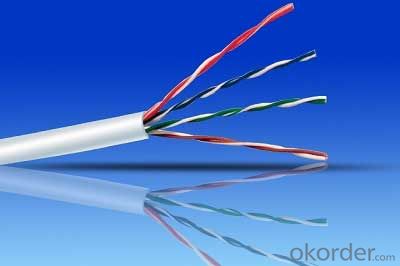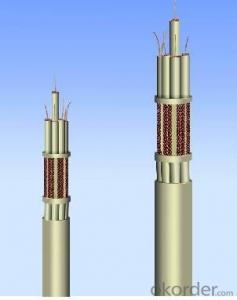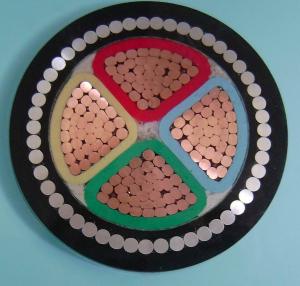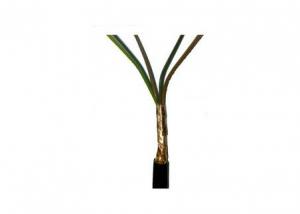Lift parts elevator compensation cable for home elevator system/electrical cable/cabel
- Loading Port:
- China main port
- Payment Terms:
- TT OR LC
- Min Order Qty:
- 500 m
- Supply Capability:
- 50000 m/month
OKorder Service Pledge
OKorder Financial Service
You Might Also Like
Specifications
1.Lift parts elevator cable
2.ISO TUV CCC
3. With Nuclear tech
4.National Enterprise Tech Certer
5. 72.6-year-life
Lift parts elevator compensation cable for home elevator system/electrical cable/cabel
Constructions
Conductor | Compact Stranded Copper Conductor, Class 2 as per IEC 60228 |
Circular solid Copper Conductor, Class 1 as per IEC 60228 | |
Flexible Stranded Copper Conductor, Class 5 as per IEC 60228 | |
Insulation | Cross-linked polyethylene (XLPE) or Polyvinyl chloride (PVC) |
Filler | Polypropylene filament with lapped binding tape |
overall Screened | Copper wire |
individually Screened | Copper wire |
Filler | PP Yarn, or Paper |
Wrapping Tape | PP |
Inner Covering | Extruded PVC |
Armour | Steel Tape |
Overall Sheath | PVC |
Applications
Compensation conductor or cable for intrinsically safe anti-explosive temperature measurement system applies low capacitance and low inductance material structure with anti-explosive safety performance, which is used for connecting with anti-explosive temperature measuring meter as anti-explosive thermocouple cable in environment of risk of explosion to form intrinsically safe thermocouple temperature measurement system.
Standards
International: IEC 60502-2, IEC 60228 IEC 60840;IEC62067 IEC332,SS299
Other standards such as BS,DIN and ICEA upon request
Technical data
1. Maximum working temperature of conductor:
Heat resistance level:F46 200℃
Soluble polytetrafluoroethylene 260℃ silicon rubber 180℃
Ordinary grade:PVC 70℃ and 105℃,cross-linked polyethylene 90℃, low smoke zero halogen antiflaming polyolefin 70℃,cross-linked type90℃and125℃.
2. Low ambient temperature:PVC jacket
Fixed laying -40℃, non-fixed laying -20℃.
3. Allowable bending radius of cable: no less than 6 times external diameter for cables without armor; no less than 12 times external diameter for copper strip shielded or steel strip armor cables; no less than 10 times external diameter for fluoroplastic insulated and jacketed cables.
Certificates
TUV, RoHS, CCC, ISO 9000,ISO10004 and more others at request
Marking
According to the customers' requirements
Nominal cross-sectional areas
0.5mm2, 1.0mm2, 1.5mm2, 2.5mm2.
Technical Data
Code, material and insulation color
Compensation wire code | Thermocouple type | Thermocouple index | Alloy material of wine | Insulation color | ||
Anode | Cathode | Anode | Cathode | |||
SC | PtRh10-Pt | S | SPC(Cu) | SNC(Cu-Ni) | Red | Green |
RC | PtRh13-Pt | R | RPC(Cu) | RNC(Cu-Ni) | Red | Green |
KCA | Nichrome-NiSi | K | KPCA(Fe) | KNCA(Cu-Ni) | Red | Blue |
KCB | KNCB(Cu) | KNCB(Cu-Ni) | Red | Blue | ||
KX | KPX(NiCr) | KNX(NiSi) | Red | Black | ||
NC | NiCrSi-NiSi | N | NPC(Fe) | NNC(Cu-Ni) | Red | Grey |
NX | NPX(NiCrSi) | NNX(NiSi) | Red | Grey | ||
EX | NiCr-CuNi | E | EPX(NiCr) | ENX(Cu-Ni) | Red | Brown |
JX | Fe-CuNi | J | JPX(Fe) | JNX(Cu-Ni) | Red | Purple |
TX | Cu-CuNi | T | TPX(Cu) | TNX(Cu-Ni) | Red | White |
Model | Name |
KX-G-VVP | PVC insulated and sheathed & copper net shielded general compensating cable |
KX-G-VRP | PVC insulated and sheathed & shielded general compensating flexible cable |
ZR-HsVP | PVC insulated & copper net shielded precision compensating cable(Anti-flaming) |
ZR-HsRVP | PVC insulated & copper net separated and total shielded precision compensating cable(Anti-flaming) |
KX-G-FFP | Anti-high temperature and shielded general compensating cable |
ZR-KX-G-FP | Anti-high temperature and shielded compensating cable(Anti-flaming) |
ZR-KX-FFP2 | Anti-high temperature copper tape total shielded compensating cable(Anti-flaming) |
ZR-KX-GR | Anti-high temperature and shielded compensating flexible cable(Anti-flaming) |
KX-Hs-GGR | Silicon rubber insulated and sheathed compensating flexible cable |
KX-Hs-FVP2FP2 | Anti-high temperature copper tape separated and total shielded compensating cable |
NH-KX-Hs-FP | Anti-temperature and fireproof compensating cable |
GZR-KX-Hs-FFP | Anti-temperature precision compensating cable(High anti-flaming) |
HT-KX-HsFVP | Special anti-heat shielded precision compensating cable |
Outer diameter referred of Fluor plastic insulated and sheathed compensating cable
Model
| ||||||||
Number of pair | Sectional area | |||||||
KX-HsFFP-2 | KX-HsFFRP | |||||||
1 | 0.75 | 1.0 | 1.5 | 2.5 | 0.75 | 1.0 | 1.5 | 2.5 |
2 | 6.2 | 7.7 | 8.2 | 9.3 | 6.4 | 8.2 | 9.1 | 10.0 |
3 | 11.7 | 12.8 | 14.1 | 16.4 | 10.7 | 12.3 | 13.8 | 16.8 |
4 | 12.3 | 13.9 | 14.9 | 17.4 | 13.0 | 13.8 | 14.8 | 17.6 |
5 | 14.4 | 15.6 | 16.3 | 19.1 | 14.7 | 15.7 | 16.1 | 18.8 |
7 | 15.5 | 16.9 | 18.3 | 21.2 | 15.9 | 17.0 | 18.3 | 20.0 |
10 | 16.7 | 18.3 | 20.9 | 23.8 | 17.2 | 18.4 | 19.5 | 23.4 |
12 | 18.8 | 21.8 | 24.7 | 29.3 | 20.4 | 21.0 | 24.8 | 29.1 |
14 | 21.4 | 23.6 | 28.7 | 33.3 | 22.0 | 23.7 | 27.0 | 32.1 |

- Q: Where can I buy a power cable with converter for a Dell Inspiron 2200?
- my okorder /
- Q: I had a power outage and I fixed it and now my cable wont work. The cable box is on it's just that there is no picture and not even the control can make it work. Can anyone figure out a way to help me with this?
- Cable modem for internet access or cable box for TV. Whatever. Unplug the effected device. Wait 10 seconds and plug it back it. Let it boot. Try finding channels (if cable box for TV) then. You may have to tune your TV to channel 3 or 4 or also do a channel search. Check the directions on your TV manual. If this is your cable modem, turn off PC, unplug cable modem, wait 10 seconds, plug in, wait till you have green lights, turn on PC. You should be good to go. T
- Q: I have digital cable through Cox. The receiver is plugged in, and the electricity is fine, but it won't turn on! Please help! I don't want to pay for repairs!
- If your not getting any power to the box no little green lite or humming noise coming from the box then its dead. your just going to need to get the box replaced you should be able to just bring your box in and trade it out to avoid a service call charge.
- Q: The touch in Australia is too expensive so i want to buy one from overseas. Will I get a quality one from Bali (I have been there before) or would the USA be better quality wise? If i do get one from Bali can i change the language? also if i buy a Ipod Touch in the USA or Indonesia can I use a Ipod Touch power cable from Australia with it?
- well idk about quality, i mean they all SHOULD be the same, they are from the same company and they're pretty much the same thing...so idk about that, but USA is USUALLY a good choice. I think if u get one in Bali they should have it automatically set up to the language they speak, or else why would apple make them international if people can't even understand what they say? idk what you mean by power calble, however, the standard voltage in Australia may be more or less then USA. There are usually products that you can buy at best buy or any electronic store that allow you to plug you're ipod into a different countries plug so that you can charge it and it wont blow out just ask a representative at best buy ;)
- Q: So i found a old monitor but cant find the power cable what cable do i need?
- web page is not available
- Q: I was walking through the bush recently and I noticed that there were cable towers separated by a valley. How would they get the cable between the towers when there is a cliff on either side?
- from what I understand, a leading cable/rope is shot across the valley if the distance is not too great. The other end of the leading cable/rope is then attached to the main power cable. The end of the leading cable is then slowly strung through the transmission mast to pull the main cable across the valley.
- Q: Power cable YJV22-8.7 / 15kv-3 * 300 what meaning
- (Including the insulation layer) of the total area should not be greater than 40% of the internal cross-section; . the tube wire is not allowed to have joints and twist the phenomenon; . the same loop of the phase of the wire, Regardless of the number of roots should be penetrated into a tube, and different circuits and different voltage lines are not allowed to wear a tube, AC and DC line wires shall not wear a tube, a phase line are not allowed to penetrate alone Steel Pipe. If the requirements are not strict, the power cable, the control cable can wear the same tube; but the signal line will be discretionary, although the signal line is shielded cable, but in order to maximize the signal transmission quality, and other signal lines are generally layout. UPVC plastic pipe with excellent insulation, acid, corrosion resistance, many chemical plants used as infusion piping. The other is also used for sinking engineering, medicine piping works, mineral salt water piping works, electrical piping works. Also widely used as a telecommunications cable. So it can be UPVC pipe to do electrical piping. As for the galvanized steel pipe is not necessary. If the power cable and signal cable at the same time with UPVC pipe laying, were classified separately perforated, the best interval between the two 20cm to prevent interference, with galvanized steel pipe pipe is not necessary so care.
- Q: Where can i find the power cable for this specific TV brand ? GO-VIDEO-2050..?
- Most TVs use two different types of power cable with either a normal female end or a two-prong narrow female end. Go to Best Buy and most likely you can find what you need.
- Q: I'm getting some upgrades for my pc and that includes a new power supply with the necessary amperage and 2 6-pin pci-e connectors to power my card. The card is already here but the psu probably won't get here until next week. I want to know if there is any way to run the card from the power coming from the pci-e slot. The card requires 2x 6-pin connectors, but i want to install it now to get that out of the way...
- No, it will simply not work as the additional power supply is needed even for normal operation (not just gaming). This is designed to avoid overloading the motherboard's power circuits.
- Q: printer is powered on. cables are securely connected. printer has ink and paper. printer installed as network printer on all client computers. other users are able to print to the printer. but printer not working on the other computer
- Check if the other computer has the printer as default. Go to printers and faxes and check from there.
Send your message to us
Lift parts elevator compensation cable for home elevator system/electrical cable/cabel
- Loading Port:
- China main port
- Payment Terms:
- TT OR LC
- Min Order Qty:
- 500 m
- Supply Capability:
- 50000 m/month
OKorder Service Pledge
OKorder Financial Service
Similar products
Hot products
Hot Searches
Related keywords





















